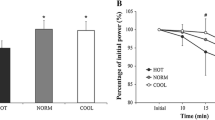Summary
The purpose of this study was to compare thermoregulatory responses between upper body and lower body exercise. Nine male subjects performed 60 min of arm crank (AC) and cycle (CY) exercise at the same absolute intensity (oxygen uptake=1.61·min−1) and at the same relative intensity (60% of ergometer specific peak oxygen uptake) in a temperate (24‡ C, 20% rh) environment. During the absolute intensity experiments, rectal temperature and sweating rate responses were essentially the same for both modes of exercise. In addition, no differences were found for chest, back, arm, or thigh skin temperatures, but calf skin temperature was significantly (P<0.05) lower during arm crank than cycle exercise. During the relative intensity experiments, thermoregulatory responses were lower during arm crank than cycle exercise. In addition, we found no difference between esophageal and rectal temperature values elicited by arm crank exercise. These results indicate that the examined thermoregulatory responses are independent of the skeletal muscle mass employed and dependent upon the absolute metabolic intensity.
Similar content being viewed by others
References
Asmussen E, Nielsen M (1947) The regulation of the body-temperature during work performed with the arms and with the legs. Acta Physiol Scand 14: 373–382
åstrand P-O, Ekblom B, Messin R, Saltin B, Stenberg J (1965) Intra-arterial blood pressure during exercise with different muscle groups. J Appl Physiol 20: 253–256
Davies CTM, Barnes C, Sargeant AJ (1971) Body temperature in exercise: effects of acclimation to heat and habituation to work. Int Z Angew Physiol 30: 10–19
Davies CTM, Few J, Foster KG, Sargeant AJ (1974) Plasma catecholamine concentration during dynamic exercise involving different muscle groups. Eur J Appl Physiol 32: 195–206
Hardy JD, DuBois EF (1938) The technic of measuring radiation and convection. J Nutr 15: 461–475
McArdle WD, Katch FI, Pechar GS (1973) Comparison of continuous and discontinuous treadmill and bicycle tests for max \(\dot V_{{\text{O}}_{\text{2}} }\). Med Sci Sports 5: 156–160
Miles DS, Sawka MN, Glaser RM, Petrofsky JS (1983) Plasma volume shifts during progressive arm and leg exercise. J Appl Physiol, Respirat Environ Exercise Physiol 54: 491–495
Nielsen B (1968) Thermoregulatory responses to arm work, leg work and intermittent leg work. Acta Physiol Scand 72: 25–32
Saltin B, Hermansen L (1966) Esophageal, rectal, and muscle temperature during exercise. J Appl Physiol 21: 1757–1762
Sawka MN, Foley ME, Pimental NA, Toner MM, Pandolf KB (1983) Determination of maximal aerobic power during upper-body exercise. J Appl Physiol, Respirat Environ Exercise Physiol 54: 113–117
Sawka MN, Miles DS, Petrofsky JS, Wilde SW, Glaser RM (1982) Ventilation and acid-base equilibrium for upper body and lower body exercise. Aviat Space Environ Med 53: 354–359
Shapiro Y, Pandolf KB, Sawka MN, Toner MM, Winsmann FR, Goldman RF (1982) Auxiliary cooling: comparison of air-cooled vs. water-cooled vests in hot-dry and hot-wet environments. Aviat Space Environ Med 53: 785–789
Simmons R, Shephard RJ (1971) Effects of physical conditioning upon the central and peripheral circulatory responses to arm work. Int Z Angew Physiol 30: 73–84
Stenberg J, åstrand P-O, Ekblom B, Royce J, Saltin B (1967) Hemodynamic response to work with different muscle groups, sitting and supine. J Appl Physiol 22: 61–70
Toner MM, Sawka MN, Levine L, Pandolf KB (1983) Cardiorespiratory responses to exercise distributed between the upper and lower body. J Appl Physiol, Respirat Environ Exercise Physiol 54: 1403–1407
Toner MM, White RE, Goldman RF (1981) Thermal stress inside the XM-1 tank during operations in an NBC environment and its potential alleviation by auxiliary cooling. US Army Research Institute of Environmental Medicine, Technical Report No. T 4/81, Natick, MA
Totel GL (1974) Physiological responses to heat of resting man with impaired sweating capacity. J Appl Physiol 37: 346–352
Wade CE, Veghte JH (1977) Thermographic evaluation of the relative heat loss by area in man after swimming. Aviat Space Environ Med 48: 16–18
Wells CL, Buskirk ER (1972) Body temperatures during contralateral arm-leg exercise. Med Sci Sports 4: 37–42
Author information
Authors and Affiliations
Rights and permissions
About this article
Cite this article
Sawka, M.N., Pimental, N.A. & Pandolf, K.B. Thermoregulatory responses to upper body exercise. Europ. J. Appl. Physiol. 52, 230–234 (1984). https://doi.org/10.1007/BF00433398
Accepted:
Issue Date:
DOI: https://doi.org/10.1007/BF00433398




